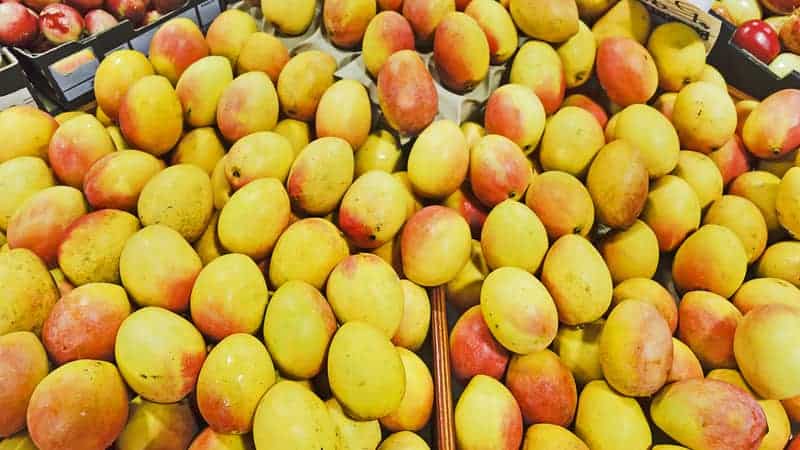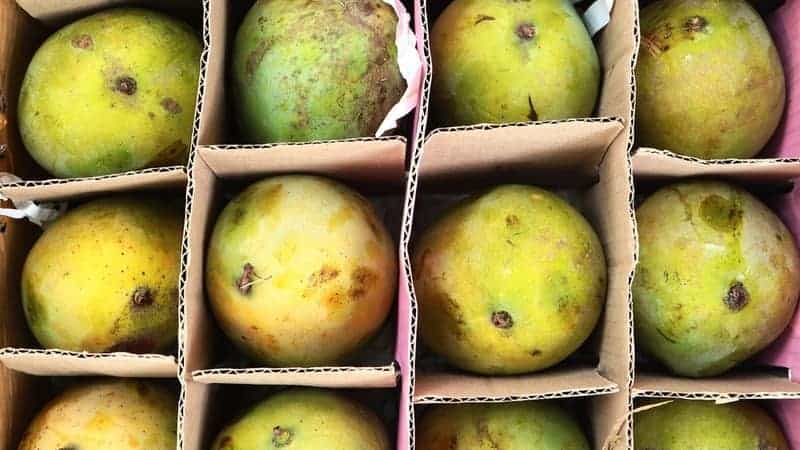Mangoes are the royalty of tropical fruits – they’re sweet, tasty, and oh-so versatile. From cobbler to smoothies, the ways to enjoy these fruits are endless.
Mango season in Australia is typically from September to January, although in some places like Western Australia, mangoes are harvested even in April. And when these fruits are in season, there’s a question on everyone’s minds.
How to store mangoes?
You can store unripe mangoes in paper bags, fruit bowls, or cardboard boxes – although this could speed up the ripening process.
For ripe mangoes, you can store them in the fridge whole or cut up. Alternatively, you can freeze mangoes in chunks, in syrup, or in puree form.
When to Store Mangoes
The best time to store mangoes in the fridge is at peak ripeness. This way, you’ll be preserving them in the best state possible.
If you’ve grown a mango tree in your backyard, you can pick mangoes that aren’t quite ripe yet.
But if you’re buying fruit from the store, choose fresh mangoes that:
- Feel a bit hefty
- Look plump (wrinkles or spots aren’t always bad)
- Have a little ‘give’ when you squeeze lightly
- Smell sweet/have a fruity aroma
- Appear yellow (often with a reddish or pinkish blush)
Some popular Australian mango varieties include Kensington Pride and Calypso.

How Long Do Mangoes Last?
The shelf life of your mangoes depends on how you’re storing them.
Unripe mangoes will turn ripe in 4–5 days at room temperature.
Ripe mangoes will last 2–3 days at room temperature, or about a week (7 days) in the fridge.
Frozen mango will last up to six months.
Dried mango will last up to a year in the pantry, and up to 2 years in the refrigerator.
Things to Remember About Storing Mangoes
Some mango varieties will last longer at room temperature – for example, Keitt mangoes have firm flesh, so they’ll have a longer shelf life than Manila ones.
The climate in your area will also affect a mango’s shelf life! If you live in a hot, humid state, your mangoes will ripen much more quickly than someone in a temperate climate.
Lastly, how and where you store mangoes depends on how long you want to keep them. If you’re planning on eating them immediately, you can leave them out at room temperature.
If you want to keep mangoes fresh longer, place them in the fridge. But if you want to keep mangoes for a long time, it’s best to freeze them.
How to Store Unripe Mangoes
If your mangoes aren’t ripe yet, you can store them in several ways. Some of these methods will help speed up the ripening process.
1. Paper bags

Fruits release ethylene, a gas that makes fruit turn ripe. If you wrap mangoes in a paper bag, you’ll trap the gas around the fruit.
The paper bag method is popular for ripening mangoes at home.
Paper bags also keep out pests – just make sure to allow air into the bag, or your fruits will spoil.
NOTE: Plastic bags could also work, but might not let the fruits ‘breathe.’
2. Fruit bowls
You can also place the mangoes in a fruit bowl on your counter! Some fruit containers come with covers that keep out fruit flies and other pests.
Storing mangoes with other fruits like bananas can also help them ripen together. Make sure you don’t use already-ripe fruits, though – that could also lead to spoilage.
3. Cardboard boxes

This is an alternative to using paper bags. Place your mangoes in a cardboard box – make sure there’s adequate air circulation.
Check on the fruits after a day to make sure they’re not beginning to spoil.
How to Store Ripe Mangoes
Easy-peasy – just place your ripe mango in the fridge! The best way to store mangoes is in your fruit bin.
The cool temperatures will slow down the ripening, so whole, ripe mangoes can keep in the refrigerator for up to a week.
How to Store Peeled or Sliced Mangoes
If you have leftover mangoes, or if you just want your fruit already cut up, there’s an easy way to store cut mangoes.
After you’ve finished cutting the mangoes, place them in an airtight container then store them in the fridge.
Always check the fruit before eating it, though. If there’s a sour smell or the pieces feel mushy, the mango has likely gone bad and must be tossed out.
How to Freeze Mangoes
How to store mangoes for a long time? Freeze them! Frozen mangoes will last for months – although you’ll notice a difference in texture versus fresh mangoes.
Remember to peel your mangoes before freezing them!
1. Freezing mangoes in chunks

Frozen cubed mango pieces are great for use in shakes or pastries. It’s also easy to pre-portion frozen mango so you only need to defrost what you need.
To freeze mangoes, start by cutting them into small cubes.
Scatter the pieces on a lined baking sheet, then place the sheet in the freezer. Leave them for at least 3 hours, but ideally overnight.
Transfer the frozen cubes to a freezer-safe bag and label them with a date.
2. Freezing mangoes in simple syrup
You can better maintain a mango’s sweetness by freezing it in syrup!
Mix 1 cup of sugar with 2 cups of water in a medium pot on the stove. Bring it to a boil, stirring constantly. Once the sugar is dissolved, set the syrup aside to cool.
Slice the mangoes into chunks and place them in freezer-safe containers. Pour in the cooled syrup so it covers the mangoes (but don’t fill the container all the way).
Place the containers in the freezer.
NOTE: You can also use simple syrup to preserve mangoes in cans!
3. Freezing pureed mangoes

This method is great for fruit leftovers, or if you’re planning to make shakes and sauces.
Toss all your mango pieces into the blender or food processor. Puree until your desired consistency.
Place the pureed fruit into freezer-safe containers. You can even pour it into ice trays for easy serving sizes!
Once you’re done, place the containers in the freezer.
4. Defrosting frozen mango
The best way to defrost mango is by placing the container in the refrigerator overnight.
If you need to defrost mangoes quickly, place the container in a pot or bag of cool water. Depending on how much mango you need, this can take 30 minutes to 3 hours.
Note that mango that’s been frozen then defrosted will feel a bit mushier than fresh mango. It shouldn’t affect the taste too much, though!
How to Make Dried Mangoes At Home
People tend to overlook drying or dehydrating mangoes to store them, but it’s a great option! Dried mango makes an excellent and healthy snack, too.
To make dried mango, start by slicing your fruits into thin slices.
Using a dehydrator, set it to about 57ºC (135ºF). The mangoes should be done between 6–10 hours.
If you don’t own a dehydrator, you can use an oven!
Place the mango slices on a lined baking sheet, then pop them into the oven. Keep the door slightly open so steam can escape.
Use your lowest setting, and flip the mangoes every hour. Depending on how big the batch is, the mangoes will be fully dry in 6–12 hours.

